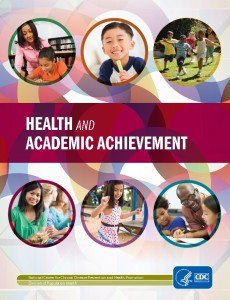 The Centers for Disease Control and Prevention recently released a toolkit on the connection between health and academic achievement and what stakeholders can do to emphasize this positive connection. Health and Academic Achievement is a toolkit that can be a very valuable resource for both schools and teachers as it details the crucial link between a student’s health and its impact on their academic achievement. The toolkit was created by public health and education professionals to emphasize the link between healthy eating, physical activity, and improved academic achievement and what stakeholders can do to create healthy school environments.
The Centers for Disease Control and Prevention recently released a toolkit on the connection between health and academic achievement and what stakeholders can do to emphasize this positive connection. Health and Academic Achievement is a toolkit that can be a very valuable resource for both schools and teachers as it details the crucial link between a student’s health and its impact on their academic achievement. The toolkit was created by public health and education professionals to emphasize the link between healthy eating, physical activity, and improved academic achievement and what stakeholders can do to create healthy school environments.
The toolkit focuses on four areas:
- Provides evidence linking healthy eating and physical activity with academic achievement
- Provides evidence driven messages that are specific to certain stakeholders
- Provides specific and feasible action steps that can be used to support healthy eating and physical activity in schools
- Highlights additional resource that can be utilized to further support your action steps.
Evidence of the link between health eating and physical activity and students academic achievement include:
- Student participation in the United States Department of Agriculture (USDA) School Breakfast Program (SBP) is associated with increased academic grades and standardized test scores, reduced absenteeism, and improved cognitive performance (e.g., memory)
- Lack of adequate consumption of specific foods, such as fruits, vegetables, or dairy products, is associated with lower grades among students.
- Hunger due to insufficient food intake is associated with lower grades, higher rates of absenteeism, repeating a grade, and an inability to focus among students
- More participation in physical education class has been associated with better grades, standardized test scores, and classroom behavior (e.g., on-task behavior) among students.
- Time spent in recess has been shown to positively affect students’ cognitive performance (e.g. attention, concentration) and classroom behaviors (e.g., not misbehaving).
The biggest takeaway from the toolkit that will the most useful for SBHC’s include the toolkits core messages and how best to communicate them to those stakeholders you are trying to influence:
Cores Messages:
- Healthy students are better learners: Healthy students are better on all levels of academic achievement: academic performance, education behavior, and cognitive skills and attitudes
- Schools can influence eating and physical activity behaviors: Students spend much of their time at school, and may eat as many as 2 out of 3 meals per day and may get much of their physical activity at school
- Healthy, successful students help build strong communities: Investing in the health of students contributes to healthy communities in the future.
- All students deserve the opportunity to be healthy and successful: Providing access to healthy foods and physical activity plays an important role in the academic achievement of students.
The toolkit emphasizes using different messages when communicating to different audiences at both the states and local levels and to incorporate at least 1-2 messages in all communication to support both healthy eating and physical activity strategies in schools, this includes communication in all forms such as conversation, PowerPoints, Webinars, meetings, presentations, Web content, e-mails, newsletters, print documents.